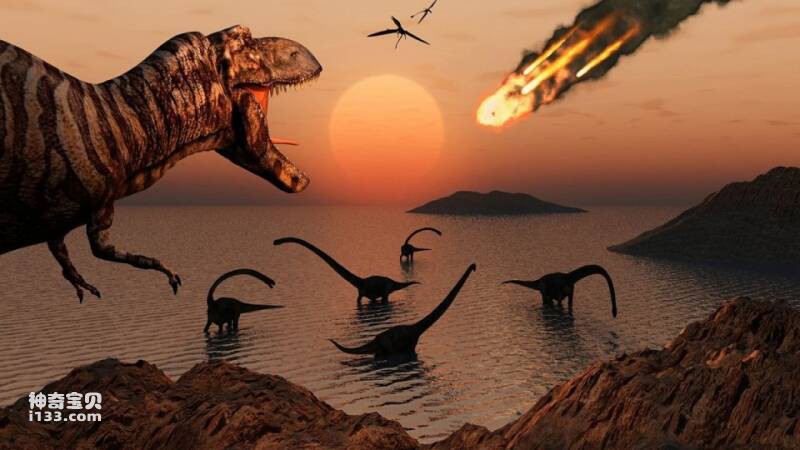Some scientists believe that the current theories on the extinction of dinosaurs emphasize external causes, such as asteroid impacts, cosmic events, destruction of the earth's ozone layer, large-scale volcanic eruptions, dramatic climate changes, etc. The most unsolvable problem of these external cause theories is, After all, why are there many biological species that were contemporaneous with dinosaurs that did not become extinct? The ecological environment and food chain they relied on for survival were not completely different from those of the dinosaurs before the mass extinction. However, they not only escaped this disaster, but also evolved into the colorful biological world today. This situation has led some scientists to consider that the more direct cause of the extinction of dinosaurs may be problems with the dinosaurs themselves. For example, the huge bodies and cold-blooded nature of most dinosaurs may be related to their extinction.

Among the many possible factors that can cause mass death of a certain biological family, new severe infectious diseases are a factor that deserves special attention. In modern times, it is common for certain pathogenic organisms to cause the extinction of specific breeding industries, and the harm of human immunodeficiency to humans is also well known. When wild animals encounter similar diseases, catastrophic damage to their populations is equally inevitable. From this perspective, there is a possibility that the extinction of dinosaurs was caused by the epidemic of highly infectious diseases. Moreover, since microorganisms are the main cause of the epidemic of infectious diseases, and changes in the ecological environment are most likely to cause their mutation, therefore, even if the extinction of the dinosaurs was caused by a disaster, the mechanism would most likely be caused by the mutation of pathogenic organisms. Achieved by the failure of the dinosaur's immune function.
The life and death caused by the interaction between organisms has always been one of the important reasons for species change in the history of biological evolution. Facing the threat of pathogenic organisms, the ability of animals to resist infection is crucial to their survival. Modern biology has proven that the anti-infection function of vertebrates mainly consists of two parts. One is the natural defense (called non-specific immunity in immunology) system, including external and internal systems composed of skin, mucous membranes, blood, etc. Barriers, as well as factors in various phagocytes and body fluids that can kill pathogens. This natural defense system is very ancient in origin. The second is the specific immune system, which is mainly composed of immune active cells that can recognize specific antigens. This specific immune system is a new functional system that only appeared after animals evolved into vertebrates, and it only reached a relatively complete level in mammals and birds.
Although it is still not possible to directly understand the function of the immune system of dinosaurs, through comparative biology methods, scientists can still speculate on the relevant situation. The immune systems of modern animals such as turtles and lizards, which are reptiles like dinosaurs, are very imperfect. They do not have complete lymphatic ducts or lymph nodes in their bodies, and the only immune organ, the thymus, is not very developed and generally does not exist. Marked differentiation of cortex and medulla. Birds are similar to reptiles in that their thymus tissue is not clearly differentiated, which is evidence that the two are closely related. However, other immune organs of birds are very developed, and their immune function is much stronger than that of reptiles. The antibodies in reptile body fluids lack diversity and are unlikely to be able to comprehensively deal with the specific immunity of various pathogenic organisms. In addition, the cold-blooded nature of reptiles also limits the proliferation rate of immune cells to some extent, making it difficult for them to adapt to the invasion of different pathogens. The immune systems of modern cold-blooded vertebrates are relatively limited in their anti-infection effects. They generally rely on their natural defense systems to non-specifically resist the invasion of pathogenic organisms, and their functions have been enhanced in some aspects, such as sharks and dogfish. Efficient defense peptides such as amines and magnin can destroy bacterial structures, thereby making up for deficiencies in the immune system and ensuring the continuation of the population. However, this strengthening factor still cannot compare with the perfect specific immune system in mammals.
As a typical representative of extinct reptiles, the immune system of dinosaurs is definitely not very perfect. If their natural defense system is not very strong, the consequences will be certain if they encounter an attack by pathogenic organisms that their defense system cannot restrain. Unthinkable.
Therefore, some scientists speculate that at the end of the Cretaceous, due to some reason (perhaps a catastrophe), a variety of new pathogenic organisms that could break through the general animal defense system suddenly evolved on the earth, causing a disease pandemic and killing a large number of dinosaurs and other Animals with defective immune systems were unable to defend themselves and became extinct. As a result, only some species of cold-blooded animals with enhanced natural defense systems survived the disaster, while warm-blooded birds and mammals were more likely to avoid bad luck because they had complete and efficient immune systems, and thus later They stood out from the new generation and became the new dominant animals on the earth.
animal tags:
We created this article in conjunction with AI technology, then made sure it was fact-checked and edited by a Animals Top editor.